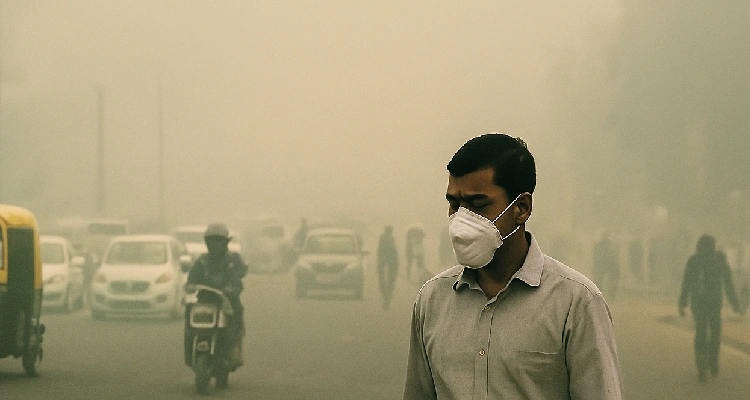|
Getting your Trinity Audio player ready...
|
If you’ve lived in Delhi long enough, you know that the city has seasons that aren’t listed in your school’s geography book. Summer, monsoon, winter… and then there’s the “smog season.” It’s that time of year when the air turns heavy, the sky goes grey, and the simple act of breathing feels like you’ve run a mini marathon, without moving an inch.
For many of us, this cycle has become as routine as Diwali lights or mango season. But the truth is, seasonal pollution isn’t just a background problem. It influences our lifestyle, our jobs, the way we commute, and even how we celebrate special moments.
The “Smog Season” Calendar
While pollution is present year-round, there’s a noticeable spike between October and January. Several factors join forces during this period:
- After the harvest season, many fields in Punjab and Haryana are cleared by burning the leftover straw.
- Firecrackers during Diwali send AQI numbers shooting up overnight.
- Temperature drop and low wind speeds which trap pollutants close to the ground.
- Dust and vehicular emissions are already part of daily city life.
According to the IQAir 2024 Report, Delhi topped the list of most polluted capital cities in the world, with an average PM2.5 level nearly 20 times above the WHO’s safe limit.
How Pollution Shapes Our Daily Routine
For a Delhiite, seasonal pollution is more than an environmental issue—it’s a lifestyle adjustment.
1. The Morning Walk Becomes a Dilemma
Many of us love a morning stroll in Lodhi Garden or a jog in Nehru Park, but during peak pollution days, the AQI app becomes our first “weather check.” If it’s in the ‘Severe’ range, even fitness enthusiasts think twice.
2. Schools and Offices on Alert
Every year, there are days when schools either reduce outdoor activities or shift to online classes entirely. In November 2023, the Delhi government even announced a temporary closure of schools for several days due to hazardous air.
3. Celebrations in the Haze
Diwali, weddings, and winter festivities often happen under a blanket of smog. Fairy lights lose their charm when the festive glow is hidden behind a smoky grey sky.
Numbers That Hit Hard
- 2 million: Vehicles registered in Delhi as of 2023, a major contributor to traffic congestion and emissions.
- 20x higher: Delhi’s PM2.5 levels compared to the WHO’s safe limit, per IQAir.
- Over 2 million: AIIMS research suggests that every year, air pollution in the NCR is linked to millions of respiratory illness cases.
The Little Adjustments We Make
As Delhiites, we’ve learned a few survival tricks for pollution season:
- Masks aren’t just for COVID anymore – N95s are now a wardrobe staple.
- Air purifiers at home – especially in bedrooms, because at least we can breathe easier at night.
- Travel timing tweaks – avoiding peak traffic hours to reduce exposure.
- Indoor workouts – swapping outdoor runs for skipping ropes, yoga, or home gyms.
- Green corners – keeping indoor plants like Areca palm or Peace lily for a small air-quality boost.
The Emotional Side of It
Seasonal pollution also affects our perception of the city. Some days you wake up to a bright winter sun, but most days, it’s like someone put a grey Instagram filter over Delhi. That constant haze can make you feel sluggish, cranky, and oddly nostalgic for clearer skies.
Can We Fix It?
It’s not all doom and gloom; there’s a growing awareness and push for change. Steps such as the Odd-Even traffic scheme, stricter emission norms, and increased CNG/public transport have made small dents in the problem. But as most of us agree over chai, this isn’t something a single policy can fix overnight
We need a mix of:
- Government action, better waste management, stricter control on industrial emissions, and sustainable farming alternatives to stubble burning.
- Public effort, reducing car use, avoiding crackers, and supporting clean energy initiatives
- Corporate responsibility, eco-friendly practices in manufacturing and logistics.
Wrapping It Up
Living in Delhi means learning to adapt to the heat, the traffic, and yes, the pollution. But it shouldn’t have to be this way forever. Every winter reminds us that clean air isn’t just a privilege; it’s a necessity.
As a born-and-bred Delhiite, I still love my city, the chaos, the food, the festivals. But I’d love it even more if I could see a clear blue sky in November without checking the AQI first.
So here’s my question for you: If you had the power to change just one thing about Delhi’s pollution problem, what would it be?
Don’t Miss: What Steps Can Be Taken to Make Delhi a Pollution-Free City?

